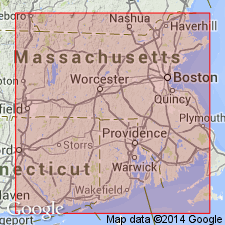
- Usage in publication:
-
- Graves Point Member
- Modifications:
-
- Named
- Dominant lithology:
-
- Conglomerate
- Slate
- AAPG geologic province:
-
- New England province
Summary:
Sedimentary sequence of proximal turbidites and overlying olistoliths on Newport Neck, southeastern RI, was originally informally named Newport formation and divided into four members by Murray and Skehan (1979). Unit was renamed Newport Neck Formation by M.J. Webster (1986) in his Master's thesis at Boston College. The Newport Neck is here restricted to the lower three members--Brenton Point, Graves Point, and Castle Hill--and the uppermost is raised in rank to Fort Adams Formation. Formation as a whole consists chiefly of gray, green, and maroon graded beds 6 cm to 1 m thick. Graded beds range from fine-grained feldspathic granule conglomerate to slate. Thickness of Graves Point shown as 100 m. Stratigraphic column indicates thin beds of tuff, carbonates, and conglomerate, interbedded with the turbidites characteristic of the other two members. Age is probably Late Proterozoic. [Members are not well described in this report and although they are used in a formal sense, intent to formalize them is not stated.]
Source: GNU records (USGS DDS-6; Reston GNULEX).
For more information, please contact Nancy Stamm, Geologic Names Committee Secretary.
Asterisk (*) indicates published by U.S. Geological Survey authors.
"No current usage" (†) implies that a name has been abandoned or has fallen into disuse. Former usage and, if known, replacement name given in parentheses ( ).
Slash (/) indicates name conflicts with nomenclatural guidelines (CSN, 1933; ACSN, 1961, 1970; NACSN, 1983, 2005, 2021). May be explained within brackets ([ ]).

